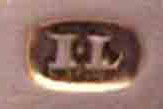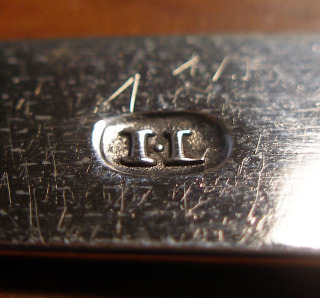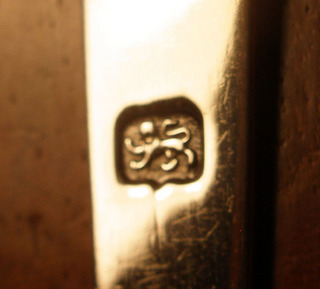|
A GLOSSARY of MILLED BANDS
|
|
| How to Post Photos |
REGISTER (click here)
|
|
A GLOSSARY of MILLED BANDS
|
|
| How to Post Photos |
REGISTER (click here)
|

|
 SMP Silver Salon Forums SMP Silver Salon Forums
  American Silver before sterling American Silver before sterling
  makers mark question makers mark question
|
| next newest topic | next oldest topic |
| Author | Topic: makers mark question |
|
argentum1 Posts: 602 |
  
 The mark is found on a sugar tong and was attributed to John Lynch of Baltimore. I question the attribution for the following reason. I have never seen this mark in any reference text or on any piece that I have seen in museums. My thought is that possibly it belongs to Lyng. Any thoughts or opinions would be appreciated. Permission to use this photo has been obtained from the owner. These are the tongs. The letters are quite different than the letters on ahwt tongs. I do not at the present time have a more clear image of the mark. IP: Logged |
|
doc Posts: 728 |
  
It's hard to judge without a photo of the full set of tongs, but Ensko has a mark that looks similar, attributed to Jeffrey Lang of Salem, MA (1707-1758). Unfortunately, I don't have scanning capabilities, but maybe someone else can post the mark? IP: Logged |
|
ahwt Posts: 2334 |
  
I think I have a pair of tongs with the same mark, but also with the lion passant mark. If I can find them I will post some pictures as I was never able to find out who the English maker was. You are right none of the documented John Lynch marks are right. IP: Logged |
|
ahwt Posts: 2334 |
  
   Here are the marks for the I•L tongs that I have. They were actually by a tea set so they were easy to find. I do not know who I•L is, except that I am petty sure that they are English and date to around the same time as your tongs. No other marks appear on my tongs. IP: Logged |
|
swarter Moderator Posts: 2920 |
  
The mark on the English tongs might be that of John Lambe of London. The letter forms on the other look similar but the mark may not be the same. IP: Logged |
|
argentum1 Posts: 602 |
  
I believe I have found the maker, James Lockwood of New York ca. 1798 to 1811. The lettering is identical as is the ever so slight irregularity of the pellet possibly from wear to the die. Absolute certainty is an elusive critter when assigning a name to a mark. I might try looking for silver in Hawaii as Ohio is now getting cold Brrrrrr. IP: Logged |
|
swarter Moderator Posts: 2920 |
  
The form of these tongs resembles a coffin-handle, which, if American, should place it aroung 1800 - 1805, too late for Lyng or Lang. Coffin-handles are all but unknown from Baltimore, so Lynch is improbable. The engraving, again if American, is of a type most often found in New York, but even though the time and place are appropriate, the only initial marks of Lockwood that I am familiar with are in a long, narrow rectangle, with wider spacing than the mark you show, and the serifs on the letters are more or less irregular. Belden shows two such marks, the second of which is more worn than the first, and so the corners are slightly rounded. Where does the mark on the tongs (or one like it) appeear as attributed to Lockwood? This may be another of those tantalizing, but unsolvable, American riddles. ahwt's English tongs could fall within this period stylistically, but they could be earlier as well (John Lambe worked from 1774 to at least 1796). IP: Logged |
|
bascall Posts: 1629 |
  
The images of the marks as is appear to be indistinguishable. IP: Logged |
|
argentum1 Posts: 602 |
  
This is why I have decided to acquire only those items which I have a fairly high degree of certainty as to maker. Full names and distinguishable marks are now perferred. Initial marks of question only if the price is really really good. I know I will be missing out on a number of nice pieces but such is life. IP: Logged |
|
Clive E Taylor Posts: 450 |
  
The IL mark with a pellet and a Lion Passant appears on a lot of English buckles and sugar tongs of the 1780 -1800 period, usually undated. There are several suspects, and as Swarter says, John Lambe is one of the favourites. My feeling is that there was quite a lot of English silver exported, unassayed, to the USA in the 1780- 1800 period. Reason for the lack of assay marks fairly obvious - no marking fee, no chance of failing assay, no need to recover the plate tax on export, and possible anti- British feeling in America after the war. Having King George's head on your silver was probably not regarded as patriotic! Some time ago I bought a pair of buckles on Ebay from the USA with merely a WB makers mark (no Lion Passant) , which I felt fairly confident was by William Ballantime of London. On receiving these I was delighted to discover that the chapes had the small stamp of RK which appears on many English buckle chapes of the Eley type of the period . Incidentally anyone knowing the identity of RK as a spring chape maker please let me know - I've been trying to trace him for years ! Probably a clock or watchmaker, gunsmith or scientific instrument maker. Certainly used to making small mechanical bits . As American silver of the Georgian period has a value and scarcity far exceeding the equivalent British items, there does seem a general desire of dealers to claim American origin if possible. Like the habit of some US dealers to attribute all silver shoe buckles to military officers ! [This message has been edited by Clive E Taylor (edited 11-29-2007).] IP: Logged |
|
bascall Posts: 1629 |
  
quote: Richard Knowlton is Listed in Lowndes's London Directory for the period 1776 to 1800 as a sword cutler among other occupations. Individuals with the initials "R K" in any of the related trades are rare in England, Scotland has a several though. IP: Logged |
|
Clive E Taylor Posts: 450 |
  
Many thank Bascall. I do not have a copy of Lowndes's London Directory so your information is very useful - I will pursue the lead. What other trades does it give for Richard Knowlton ? He is listed in the Universal British Directory of 1791 as a Hatter and Sword Cutler in Fleet Street but I had not previously considered a sword cutler. However you have a point (no pun intended !). Sword cutlers in this period I believe very rarely made blades (these were imported) merely making the hilts and fitting and assembling the package -so someone who was a hilt maker might have branched out, especially as swordwearing was very much out of style by the 1780's. As a haberdasher he seems to have been going towards fashion accessories anyhow. The problem I find is that the trade directories of the day did not seem to work on a free entry basis, many of the leading silver bucklemakers have no entries - probably too mean to pay for entry! IP: Logged |
|
bascall Posts: 1629 |
  
Richard Knowlton's occupations other than those already mentioned include clothing and weaponry. His name came up after scanning about 3000 tradesman. There was one silversmith with the initials "RK." Have to look again to see who he was. By the way, you may already be aware of this, but swords also have fittings that are called chapes. IP: Logged |
|
Clive E Taylor Posts: 450 |
  
I did not realize that "chape" also applies to sword fittings but on looking up the Oxford English Dictionary I find that the word has four meanings - all linked
The only London registered RK silversmiths I know are Richard Kersill (too early ) Robert Knight (goldworker c1780 to c1800) and Robert Kell(e)y (too late !). I feel that RK is almost certainly a London or a Birmingham area man. May be even a locksmith . My own suspicion is that he may be one of the Kings who appear sporadically as silver bucklemakers in the 18th century and whom I feel are all probably related.
IP: Logged |
|
bascall Posts: 1629 |
  
Richard Kempsfield is listed in The Hampshire Directory, 1784 as a silversmith and watch and clock maker. The information about the word chafe is very interesting. A good breakdown of the origination of the word chafe would be nice, but so far, it hasn't been easy to find. The actual idendity of your chafe maker is still a mystery to me. These have been just a couple vague suggestions. It may be a plus though that there are so few London area metal workers with the initials "R K." IP: Logged |
|
Clive E Taylor Posts: 450 |
  
Now a new suspect. Right sort of date (Eleys Patent was 1784 and the RK versions were slightly later) Silversmith ticks a box Watch and clock maker ticks ( no pun intended ) another. Hampshire is close enough to London Not enough to arrest the guy on suspicion, but I can certainly bring him in for questioning Very many thanks indeed. Two new leads Clive IP: Logged |
|
argentum1 Posts: 602 |
  
I have decided to remove this thorn once and for all time. I am selling it without any attribution. This ought to teach me to stop buying what I am not reasonably certain of or comfortable with. I had questions about it but it looked nice so I thought 'what the heck'. Will I do it again, most likely as I do need to get a 'fix' every now and then. But for some reason this one really annoyed me but if I had had some positive proof of maker I would have kept it no matter what. IP: Logged |
|
Silver Lyon Posts: 363 |
  
Don't sell! These are nice pre 1784 London made tongs - John Lambe for sure. Remember that even some of the better reference books suffer from optimism when matching maker's marks to makers who just happen to have the same initials - so things ain't always what they seem to be. IP: Logged |
|
Clive E Taylor Posts: 450 |
  
Whereas I agree heartily with Silver Lyons view on the desirability of these tongs, I appreciate Argentum1's viewpoint. If you specialize in an area, say American silver, you try to keep in that confine. I would love to branch into all sorts of areas of silver - but limited financial resources - and we all have limits to our spending - means I restrict myself to one field. In my opinion it it better to have a comprehensive collection in one field, rather than spread oneself out over several.You can , and should, appreciate all relevant adjoining areas, but you cannot buy everything. IP: Logged |
|
ahwt Posts: 2334 |
  
It seems to me that if the object is actually used for it intended purpose it should not count as part of a collection. If it is not part of a collection different rules should apply as to the amount that can be purchased. IP: Logged |
|
Clive E Taylor Posts: 450 |
  
What a great idea ahwt ! I suspect though that my wife would either not fall for that one , or would find something that took even more of the family budget for something she fancied ! Who uses lump sugar today - OK its for ice cubes ! IP: Logged |
|
argentum1 Posts: 602 |
  
I have maintained the following stand for quite a few years and I will not change it. You can do what ever you wish but .... I consider myself to be a trustee of those items which I collect. As such, I would never do anything to those collectibles that may in any way endanger there continued existence. I have agreed to repairs when the repair is required to maintain its integrity (structural integrity). As items are used and polished there is a minute amount of silver lost and crispness/detail suffers. Granted it takes a long time for that to affect the piece but I do not want to be part of that damage no matter how small. As I said, do what you will and I will try my best to see that my pieces are passed on to the next generation in as good condition as received. IP: Logged |
|
argentum1 Posts: 602 |
  
This is from a gentleman in England. Tongs, before 1790, rarely had date letters. A general rule of thumb is 1770 to 1784 there were two marks: a lion passant and the makers mark. Then 1784 to 1786 there three marks and these were a lion passant, makers mark and an incuse duty mark which is considered rare. From 1786 to 1790 the same three marks except the incuse mark is now intaglio and is the more common of the two duty marks. It is always possible for there to be only the makers mark but this is rarely seen as it would make the piece illegal under the British marking system. The Americans quite often ordered items from England and then place their mark on it or have the English maker place the American mark on it. So, your tongs could, by style , be English but sold by an American smith as American pieces are most commonly found with a makers mark only. I thanked the gentleman for sharing his knowledge but still have no idea as to the maker. IP: Logged |
All times are ET | next newest topic | next oldest topic |
  |
|
Ultimate Bulletin Board 5.46a
|
1. Public Silver Forums (open Free membership) - anyone with a valid e-mail address may register. Once you have received your Silver Salon Forum password, and then if you abide by the Silver Salon Forum Guidelines, you may start a thread or post a reply in the New Members' Forum. New Members who show a continued willingness to participate, to completely read and abide by the Guidelines will be allowed to post to the Member Public Forums. 2. Private Silver Salon Forums (invitational or $ donation membership) - The Private Silver Salon Forums require registration and special authorization to view, search, start a thread or to post a reply. Special authorization can be obtained in one of several ways: by Invitation; Annual $ Donation; or via Special Limited Membership. For more details click here (under development). 3. Administrative/Special Private Forums (special membership required) - These forums are reserved for special subjects or administrative discussion. These forums are not open to the public and require special authorization to view or post. |
|
copyright © 1993 - 2022
SM Publications
All Rights Reserved. Legal & Privacy Notices |